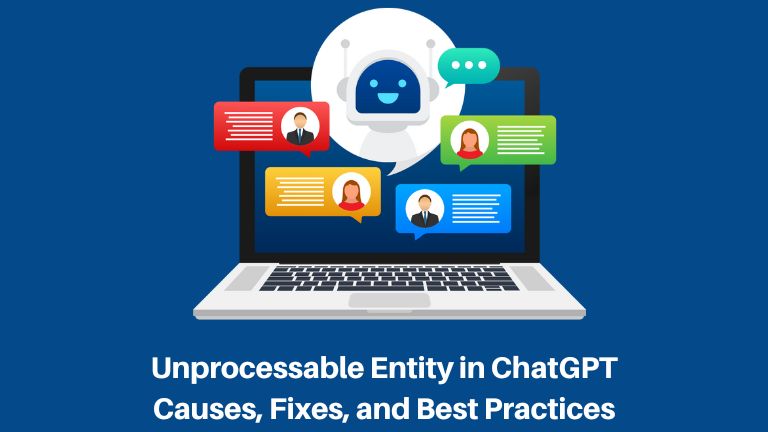Artificial Intelligence (AI) has revolutionized various aspects of our lives, and one of its remarkable applications is language generation. ChatGPT, developed by OpenAI, is an advanced language model that uses deep learning techniques to generate human-like responses. However, encountering an “unprocessable entity” error while using ChatGPT can be frustrating.
In this article, we will delve into the intricacies of the unprocessable entity error in ChatGPT, exploring its causes, and potential solutions, and offering insights into enhancing your experience with this powerful tool.
What is Unprocessable Entity ChatGPT?
Unprocessable Entity is an HTTP status code that signifies an issue with the submitted data. In the context of ChatGPT, encountering an unprocessable entity error typically indicates a problem with the input provided to the model. This error is often triggered when the input doesn’t conform to the expected format or fails to meet certain requirements. For example, if the input is too long, contains invalid characters, or lacks essential information, ChatGPT may fail to process it and return an unprocessable entity error.
While the error message itself can be frustrating, understanding the possible causes can help troubleshoot and improve your interactions with ChatGPT.
Common Causes of Unprocessable Entity Errors
- Invalid Formatting: ChatGPT expects well-formatted inputs. Ensure that your text adheres to the expected format, including punctuation, sentence structure, and paragraph breaks.
- Excessive Length: Lengthy inputs can overwhelm ChatGPT, causing it to encounter difficulties in processing the data. Consider breaking down complex questions or sentences into smaller, more manageable parts.
- Invalid Characters or Symbols: Some characters or symbols may not be recognized by ChatGPT, resulting in an unprocessable entity error. Check for any uncommon or unsupported characters in your input and replace them with appropriate alternatives.
- Lack of Context or Information: ChatGPT relies on context to generate relevant responses. If the input lacks necessary information or context, it might lead to an unprocessable entity error. Ensure that your queries or prompts provide sufficient context for ChatGPT to understand and respond appropriately.
- Inconsistent Language: ChatGPT is primarily trained on English language data. Using a mix of languages or employing non-standard English might confuse the model and trigger an unprocessable entity error. Stick to using standard English for optimal results.
- Incomplete or Ambiguous Queries: If your queries or prompts are incomplete or ambiguous, ChatGPT may struggle to comprehend the intended meaning, resulting in an unprocessable entity error. Clearly articulate your questions or prompts to improve the model’s understanding.
Conclusion
Encountering an unprocessable entity error with ChatGPT can be frustrating, but understanding its causes and implementing effective strategies can help enhance your experience. By adhering to proper formatting, providing sufficient context, and ensuring the input meets the model’s requirements, you can minimize the occurrence of this error and maximize the benefits of ChatGPT’s language generation capabilities. Embrace the potential of AI-driven language models and enjoy engaging conversations with ChatGPT!
Frequently Asked Questions (FAQs)
Why am I encountering the “unprocessable entity” error with ChatGPT?
The “unprocessable entity” error occurs when the input provided to ChatGPT does not conform to the expected format or fails to meet certain requirements. This error can be triggered by factors such as invalid formatting, excessive length, invalid characters, lack of context or information, inconsistent language usage, or incomplete and ambiguous queries.
How can I resolve the “unprocessable entity” error?
To resolve the “unprocessable entity” error, consider the following steps:
- Review and correct the formatting of your input.
- If your input is lengthy, break it down into smaller, more manageable parts.
- Check for any invalid characters or symbols and replace them with appropriate alternatives.
- Ensure your queries or prompts provide sufficient context and relevant information.
- Stick to using standard English and avoid mixing languages.
- Articulate your questions or prompts clearly, avoiding ambiguity.
Can I use special characters or symbols in ChatGPT?
While ChatGPT supports a wide range of characters and symbols, it is advisable to stick to commonly used ones. Using uncommon or unsupported characters may lead to an unprocessable entity error. If possible, replace such characters with appropriate alternatives.
How can I provide sufficient context for ChatGPT to generate accurate responses?
When interacting with ChatGPT, it is essential to provide clear and concise context. Include relevant details, specify the desired outcome, and ensure your prompts or queries are complete. The more context you provide, the better ChatGPT will understand your intentions.
Can the length of my input affect the occurrence of the “unprocessable entity” error?
Yes, the length of your input can influence the likelihood of encountering the “unprocessable entity” error. If your input is excessively long, consider breaking it down into smaller segments. This approach helps ChatGPT process the data more effectively and reduces the chances of triggering the error.
Does the language used in my queries or prompts impact the occurrence of the “unprocessable entity” error?
Yes, the language used in your queries or prompts can influence the occurrence of the “unprocessable entity” error. ChatGPT is primarily trained on English language data, so using a mix of languages or non-standard English might confuse the model and trigger the error. Stick to using standard English for consistent and accurate responses.

